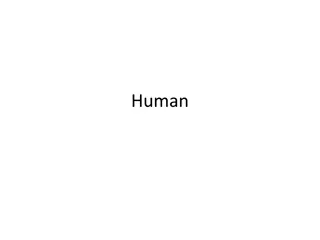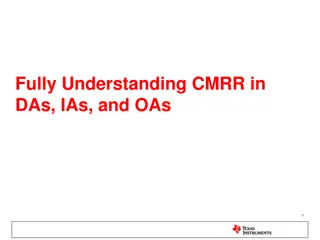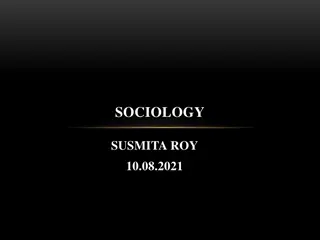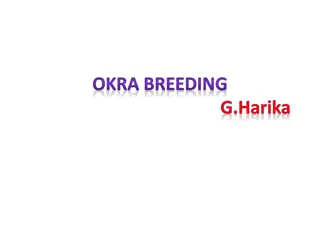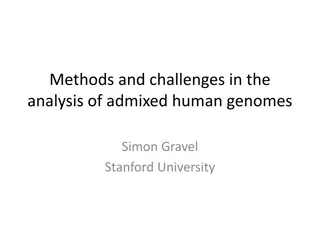
Biogeography, Homologous vs. Analogous Structures, and Cellular Homology
Explore the fascinating world of biogeography, examining the distribution of plants and animals across Earth's history, from Pangaea to species isolation. Delve into homologous and analogous structures, distinguishing between them with examples. Discover the molecular and cellular homology shared among living organisms, shedding light on evolution and common ancestry.
Download Presentation

Please find below an Image/Link to download the presentation.
The content on the website is provided AS IS for your information and personal use only. It may not be sold, licensed, or shared on other websites without obtaining consent from the author. If you encounter any issues during the download, it is possible that the publisher has removed the file from their server.
You are allowed to download the files provided on this website for personal or commercial use, subject to the condition that they are used lawfully. All files are the property of their respective owners.
The content on the website is provided AS IS for your information and personal use only. It may not be sold, licensed, or shared on other websites without obtaining consent from the author.
E N D
Presentation Transcript
PROVE IT! Biogeography Biogeography Homologous and Analogous Structures Homologous and Analogous Structures Fossil record Fossil record
BIOGEOGRAPHY The geographic distribution of plants and animals over the surface of the Earth Pangaea Pangaea 270 million years ago all of the planet s land mass was combined into one super continent 200 million years ago it broke apart forming the current continents
BIOGEOGRAPHY Oceans separated land masses leading to species isolation Isolated populations developed unique mutations and adaptations, eventually becoming their own species.
BIOGEOGRAPHY A microcosmic example of this isolation are the Kaibab and Abert squirrels on the Northern and Southern rims of the Grand Canyon The canyon prevents gene flow from one population to the other. The squirrels many similarities suggests a common ancestor whose population was split during the last ice age. Kaibab squirrel Abert squirrel
HOMOLOGOUS AND ANALOGOUS STRUCTURES Homologous - Different organisms with similar structures due to common descent Example: forelimb in a cat and a whale Analogous - Different organisms with similar structures due to similar environmental challenges and selective pressures Example: moth wings and bat wings Show what you know! Show what you know! Homology vs Analogy Homology vs Analogy
MOLECULAR/CELLULAR HOMOLOGY Living things are remarkably similar at the cellular and molecular level. These fundamental similarities are most easily explained by evolutionary theory: life shares a common ancestor. SHARE 50% OF THEIR SHARE 50% OF THEIR DNA HUMANS AND BANANAS HUMANS AND BANANAS DNA
CELLULAR HOMOLOGY All organisms are made of cells All cells are remarkably similar in structure and function
Comparing Animal and Plant Cells Plant Cell Animal Cell Cell Membrane Cytoplasm ER (smooth and rough) Ribosomes Mitochondria Golgi apparatus Nucleus Variety of Shapes One or more small vacuoles Centrioles Lysosomes Often have cilia or flagella Cell Wall Rectangular One large, central vacuole Rarely have lysosomes Plastids Chloroplasts Rarely have cilia or flagella
MOLECULAR HOMOLOGY The DNA code is a homology linking all life. DNA and RNA possess a four-base code that provides the recipe for all living things. In some cases, transferring genetic material from the cell of one living thing to the cell of another, results in the recipient following the new instructions.
DEVELOPMENTAL HOMOLOGY Similarities between embryos of different species suggests shared ancestry; even across different classes of animals (Reptilia, Mammalia, etc).
DEVELOPMENTAL HOMOLOGY EXAMPLE Toothed whales have full sets of teeth throughout their lives Baleen whales (such as the Blue whale) only have teeth in the early fetal stage. This suggests that both toothed and baleen whales share a common ancestor.
ANATOMICAL HOMOLOGY Comparing the structure and function of the same bones in different species provides a rough estimate of how far back the common ancestor was.
FOSSIL RECORD A way for scientists to see the small adaptations that happen in species over time Provides much proof for common ancestry between animals Enables scientists to better pinpoint when certain species existed and help determine whether they may be related to other species.
DATING THE FOSSIL RECORD Depth at which fossils are found helps determine relative age ( older or younger than other fossils) Older fossils are found deeper, as shown in sedimentary rock
RADIOMETRIC DATING A technique used to date materials such as rocks or carbon, usually based on a comparison between the observed abundance of a naturally occurring radioactive isotope and its decay products, using known decay rates.
EVOLUTIONARY TREES Represent evolutionary relationships among a set of organisms or groups of organisms, called taxa (singular: taxon) Tree tips represent groups of descendent taxa (often species) and tree nodes represent common ancestors
EVOLUTIONARY TREES Phylogeny, Phylogenic Tree, and Cladogram Terms often used interchangeably A tree structure that represents the evolutionary relationships within a group of organisms Clade - a group of organisms that includes an ancestor and all descendants of that ancestor
EVOLUTIONARY TREES Click here to make your own tree: Reconstructing Trees
DIG DEEPER! List the three methods scientists use to prove common ancestry. Give an example of geographic isolation and to what might it give rise? What is the difference between a homology and analogy? Why is the fossil record important to scientists?






